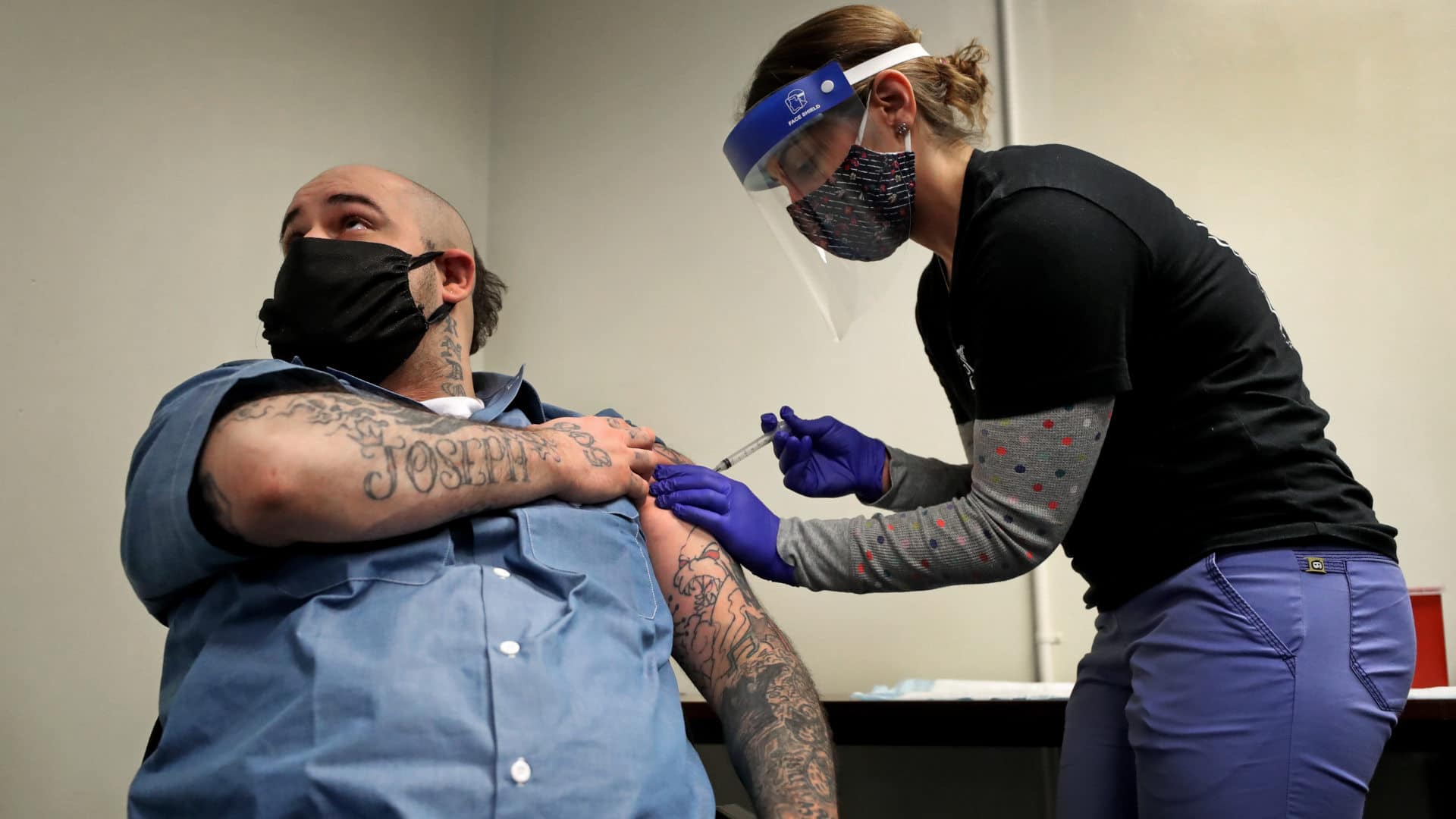In March 2020, as Covid-19 spread across the United States, one of the largest outbreaks in the country emerged at the Cook County Department of Corrections jail in Chicago, with more than 900 cases among detainees and staff in a matter of weeks.
Other jails and prisons were experiencing outbreaks, too, and by late spring epidemiologists and journalists were sounding alarms that three kinds of facilities — prisons, nursing homes, and meatpacking plants — were especially vulnerable to Covid-19.
Nursing home residents and workers began receiving Covid-19 vaccinations in December 2020 and January 2021. Meatpacking plant workers have had to wait longer, but were eligible for shots in at least 26 states by late March.
But people in prisons are largely still waiting. Although guidelines from the Centers for Disease Control and Prevention recommend that states prioritize prison staff for vaccination — and vaccinate detainees at the same time — vaccination in prisons remains patchy. This is despite the fact that Covid-19 vaccine access is otherwise expanding, with the country seeing a one-day record of 4 million shots on Saturday.
“Prisoners, not free to seek out vaccines, still lack access to them on the whole,” reported a team of journalists from The Marshall Project and the Associated Press this week. In Florida, for instance, officials declined for weeks to send doses to the more than 70,000 people incarcerated in state prisons, only reversing the policy this week. In New York, a judge last week compelled the state to begin offering vaccination to prisoners, ruling that policies excluding them “irrationally distinguished between incarcerated people and people living in every other type of adult congregate facility.”
Even once vaccines are available, The Marshall Project and AP report, incarcerated people often distrust prison medical staff and have little access to information about vaccine safety, potentially hampering efforts to deliver the shots. Already, vaccine refusal rates among prisoners — and staff — are high in many facilities.
The effects could extend beyond prison walls. While social distancing measures have helped improve conditions in other kinds of shared spaces, prisons have remained uniquely vulnerable to rapid Covid-19 spread. And as Rod McCullom reported for Undark last fall, there’s growing evidence that outbreaks in prisons and jails can fuel community spread due to “the constant traffic of detainees, staff, visitors, vendors, and law enforcement in and out of these facilities.” Those broader outbreaks may especially harm Black communities, which are disproportionately affected by mass incarceration.
And, some advocates say, the pandemic has highlighted longstanding overcrowding in the U.S. prison system, the world’s largest. That issue, which has driven the swift spread of Covid-19, won’t go away with vaccination. “That’s the elephant in the room with this pandemic,” researcher and advocate David Cloud told Undark earlier this year. “Just by virtue of 40 years of mass incarceration, you have so many people, so many humans, living in very small, terrible spaces.”
Also in the News:
• A new contract has extended the life of a key federal program that law enforcement, forensics experts, and family members use to find missing and unidentified people. Late last year, as Undark reported, the fate of the National Missing and Unidentified Persons System (NamUs) was uncertain. At the time, NamUs was managed by the University of North Texas Center for Human Identification. In December, the Texas center abruptly announced that it would “no longer be able to support NamUs stakeholders with any analytical or case support; victim services; system development; or new forensic services.” The center later walked back the announcement, stating it would host NamUs through September 2021. But now, according to a post in Forensic Magazine by an official in the government institute that funds NamUs, management of the program is moving to the North Carolina-based Research Triangle Institute (RTI) International, with some continued support from the University of North Texas. Since NamUs launched in 2007, it has helped law enforcement solve 2,700 missing persons cases and identify over 2,000 human remains. And now, NamUs will also be incorporated into new programs from the Biden administration: Late last week, Secretary of the Interior Deb Haaland announced the formation of the Missing & Murdered Unit, which will focus on American Indians and Alaska Natives — and which will, in part, be used to enhance the NamUs database. (Forensic Magazine)
• The cherry blossom bloom in Kyoto peaked in late March this year — a worrying sign of a warming climate, experts say. Since 812 A.D., people in the Japanese city have recorded the peak bloom date of the trees. “The Kyoto Cherry Blossom record is incredibly valuable for climate change research because of its length and the strong sensitivity of flowering to springtime temperatures (warmer springs = earlier flowering, typically),” wrote Benjamin Cook, a climate researcher at Columbia University, in an email to The Washington Post. The record shows stable flowering dates until 1800. Since then, with warming temperatures, the average peak bloom dates have shifted earlier in the spring, although, paradoxically, warmer winters can occasionally delay the bloom. “In 1850, the average flowering date was about April 17,” the Post reports. “Now it’s closer to April 5.” Over the course of those years, the average temperature has risen in Kyoto by around 6 degrees Fahrenheit. Similar trends have been observed in cherry trees at the Tidal Basin in Washington, D.C. Apart from serving as a vivid indicator of climate change, the early flowering of cherry blossoms may make the trees more susceptible to spring freezes. It could also hamper pollination: If the trees bloom before bees are active, one expert warned, the bees could end up hungry while the cherry blossoms suffer from poor pollination. (The Washington Post)
• As cases of Covid-19 spiked in India this week, the world’s largest vaccine manufacturer warned that funding shortfalls, limited capacity, and high demand had put it in a “very stressed” position. Adar Poonawalla, the head of The Serum Institute of India, said that without an injection of government funds, the company would not be able to make some critical expansions to its production schedule, which would further limit vaccine supplies both at home and abroad. The Serum Institute is a major producer of the AstraZeneca vaccine. As cases have surged in India, the government has required the company to divert supplies promised to other countries for domestic use instead. As result, delays of shipments to countries awaiting the vaccine have been so pronounced that AstraZeneca filed a legal complaint this week. Meanwhile, Covid-19 infections have been rising steadily during the past few weeks in the country, even as vaccination rates lag. Experts say the surge is largely related to an increase in public gatherings and face-to-face interactions — although some new viral variants may also be playing a role. (Multiple Sources)
• Late last year, researchers at Harvard University announced plans to conduct a June 2021 test flight of a high-altitude balloon designed to spew reflective particles in the atmosphere, part of a controversial proposal to stave off global warming by dimming the sun. Today, those plans have suffered a setback. The flight, which had been set to occur in Sweden near the Arctic circle, would have been the first field test of the geoengineering experiment, known as Scopex. But Sweden’s space agency, which was to conduct the launch, announced last week that it was scuttling the plans in the face of opposition from scientists, environmentalists, and Indigenous groups. Speaking to Reuters, Johanna Sandahl, president of the Swedish Society for Nature Conservation, applauded the decision as a rejection of a dangerous technology “that could alter hydrological cycles, disrupt monsoon patterns, and increase drought.” The Harvard researchers say they will continue to work to win over public opinion in Sweden, but that moving the test to a new site in the U.S is also a possibility. Either way, the launch is now likely to be postponed until at least 2022. (The New York Times)
• And finally: The Covid-19 pandemic has led to a flourishing market for face masks. Now the U.S. government is aiming to spur further innovation: The Biomedical Advanced Research and Development Authority, or BARDA, has announced a competition to design a better protective mask, declaring that it will hand out a total of $500,000 in prizes to the winners of its Mask Innovation Challenge. The National Institute for Occupational Safety and Health (NIOSH), an agency within the Centers for Disease Control and Prevention, is also partnering with BARDA to help launch and fund the competition. Up to 10 winners of the challenge’s first design phase will receive a prize of $10,000. The contest will then proceed to a proof-of-concept phase, which will award $400,000, to be divided among no more than five winners. BARDA and NIOSH hope the competition will produce a mask that addresses some common complaints about the ubiquitous safety gear, including irritated skin, muffled voices, fogged up glasses, and gaps at the sides that could allow viral particles to pass through. (The Verge)
“Also in the News” items are compiled and written by Undark staff. Deborah Blum, Brooke Borel, Lucas Haugen, Sudhi Oberoi, and Ashley Smart contributed to this roundup.










